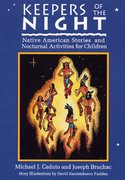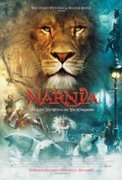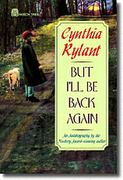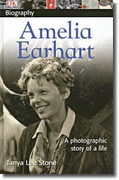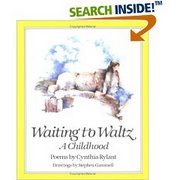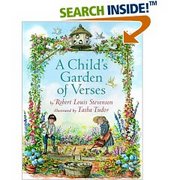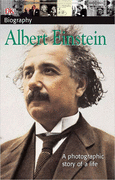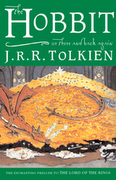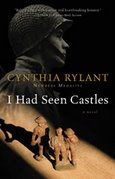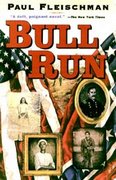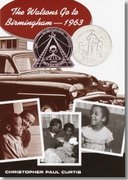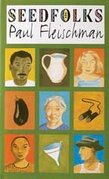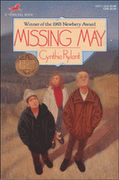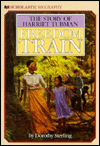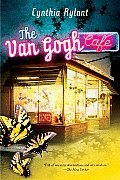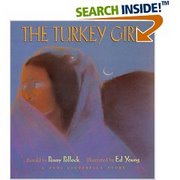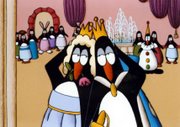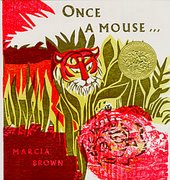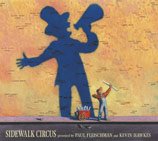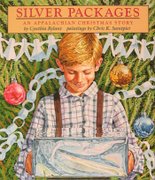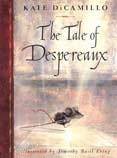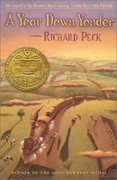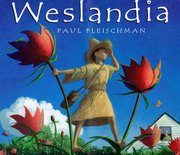by Cynthia Rylant
This may be grossly unfair but this is the sixth Newbery Award winning book focusing on how to deal with the loss of a loved one. As a result, I started and put down the book five times.
The story of an orphan, passed from relative to relative till ending up with her Aunt May and Uncle Obe is disconcerting, reflecting the angst and uncertainty many young people feel. Losing and missing her Aunt May, and how she and Obe deal with it, seems a less than ideal recommendation. When Obe starts to hallucinate or imagine May’s presence, he is encouraged at every turn by Summer and her school friend, Cletus.
Both May and Obe were eclectic and eccentric. They collected artistic and elaborate whirlygigs and mounted them inside their mobile home, and Summer clearly assumes that, though loved, she is part of the collection. After May dies, Obe becomes erratic till Cletus, a collector of empty potato chip bags and photos, visits. While I appreciate the authors point about accepting quirkiness, I found myself becoming distanced from the characters and their plight by the sheer volume of strange until I reached the following passage:
“May would have liked (Cletus). She would have said he was “full of wonders, “same as Ob. May always liked the weird ones best, the ones you couldn’t peg right off. She must be loving it up in heaven, where I figure everybody must just let loose. That’s got to be at least one of the benefits of heaven—never having to act normal again.”
And maybe that WAS the point. Dealing with devastating loss makes everything feel strange. Even normal is disorienting. Shying away from the odd and peculiar at that point is not jut futile, but counterproductive. When Summer finally broke down and cried at her loss for May, it was only after she saw Obe go through his own catharsis. Only after he was “taken care of” could she fully grieve. What was unspoken in the book, but obvious to adult readers, was that Obe was doing the same. Both cared enough about the other to help them through this dreadful time, but put off their own needs to do it. In the end this only extended the pain.
Missing May is about the need to grieve for your loss, and to help others at the same time. Getting back to “normal” is less important than letting go of the pain.
Lesson plans can be found at:
at:http://www.glencoe.com/sec/literature/litlibrary/pdf/missing_may.pdf
Tuesday, March 20, 2007
Sunday, March 18, 2007
Freedom Train: The Story of Harriet Tubman
by Dorothy Sterling
“Freedom Train” is a biography of Harriet Tubman. Harriet Tubman was interviewed many times by Northern journalists when she was elderly. Other, literate members of the Underground Railroad who met Ms.Tubman or worked with her, journaled the conversations they had with her. Fortunately, much of what was recorded took place in the North and survived intact after the Civil War. Dorothy Sterling, the author, was able to locate these accounts and use them in this biography.
I read this book aloud to my students. They were enthralled because the author made Ms. Tubman’s life come alive with the telling of beatings, cruelty, and violence. I admit that I dramatized the story as much as I could to keep them interested.
The story of Harriet Tubman’s struggle as a slave, her brave escape as a teenager, and her incredible courage as a rescuer and savior of hundreds of slaves would touch even the most cold-hearted reader. However, the pace of the story slows down too much after the John Brown uprising at Harper’s ferry.
My students lost interest in the latter part of Ms. Tubman’s life when she stopped rescuing slaves and became a political creature. Unfortunately, the last chapters drag.
Had I been the author, I would have ended the story with Harriet’s last rescue and added an epilogue to briefly explain Ms. Tubman’s later years.
Lesson Plan at:
http://teacherlink.ed.usu.edu/tlresources/units/Byrnes-famous/tubman.html
“Freedom Train” is a biography of Harriet Tubman. Harriet Tubman was interviewed many times by Northern journalists when she was elderly. Other, literate members of the Underground Railroad who met Ms.Tubman or worked with her, journaled the conversations they had with her. Fortunately, much of what was recorded took place in the North and survived intact after the Civil War. Dorothy Sterling, the author, was able to locate these accounts and use them in this biography.
I read this book aloud to my students. They were enthralled because the author made Ms. Tubman’s life come alive with the telling of beatings, cruelty, and violence. I admit that I dramatized the story as much as I could to keep them interested.
The story of Harriet Tubman’s struggle as a slave, her brave escape as a teenager, and her incredible courage as a rescuer and savior of hundreds of slaves would touch even the most cold-hearted reader. However, the pace of the story slows down too much after the John Brown uprising at Harper’s ferry.
My students lost interest in the latter part of Ms. Tubman’s life when she stopped rescuing slaves and became a political creature. Unfortunately, the last chapters drag.
Had I been the author, I would have ended the story with Harriet’s last rescue and added an epilogue to briefly explain Ms. Tubman’s later years.
Lesson Plan at:
http://teacherlink.ed.usu.edu/tlresources/units/Byrnes-famous/tubman.html
The Van Gogh Cafe
by Cynthia Rylant
The Van Gogh Café is a thought provoking, well written, albeit quirky little book! Each chapter is really a separate short story independent of the other chapters. The setting remains the same: a café. Marc, the owner, and Clara, his daughter, are featured in each story but not always as the main characters.
“The Possum” is a peculiar story about a possum hanging upside down from the tree across the street from the café. Possums normally are nocturnal creatures, but this one hangs around during the day. People bring food to feed the possum but wind up feeding stray animals. A stranger in town sees all this, has an epiphany, goes home and turns his home into a shelter for stray animals.
“The Star” features a dapper, dignified elderly man who enters the café and stays all day waiting for a young man to appear. Marc, the owner, recognized the man as a silent movie star and talked to him. It turned out that the old man first performed in the Van Gogh Café when it was a theater. The old man stayed and stayed, then quietly died. The young man he had been waiting for was himself.
“The Wayward Gull” made me smile. Somehow, a directionally challenged seagull wound up in Kansas on top of the café roof. The gull drew so much attention, good and bad, that Clara told it to head to California. The next thing the reader knows is that a group of gulls and a moving van headed to California have arrived. Shortly, the van leaves for California with a rooftop full of seagulls.
My class will love the “Van Gogh Café”, and I can read as many or as few chapters as I want, and time permits.
The Van Gogh Café is a thought provoking, well written, albeit quirky little book! Each chapter is really a separate short story independent of the other chapters. The setting remains the same: a café. Marc, the owner, and Clara, his daughter, are featured in each story but not always as the main characters.
“The Possum” is a peculiar story about a possum hanging upside down from the tree across the street from the café. Possums normally are nocturnal creatures, but this one hangs around during the day. People bring food to feed the possum but wind up feeding stray animals. A stranger in town sees all this, has an epiphany, goes home and turns his home into a shelter for stray animals.
“The Star” features a dapper, dignified elderly man who enters the café and stays all day waiting for a young man to appear. Marc, the owner, recognized the man as a silent movie star and talked to him. It turned out that the old man first performed in the Van Gogh Café when it was a theater. The old man stayed and stayed, then quietly died. The young man he had been waiting for was himself.
“The Wayward Gull” made me smile. Somehow, a directionally challenged seagull wound up in Kansas on top of the café roof. The gull drew so much attention, good and bad, that Clara told it to head to California. The next thing the reader knows is that a group of gulls and a moving van headed to California have arrived. Shortly, the van leaves for California with a rooftop full of seagulls.
My class will love the “Van Gogh Café”, and I can read as many or as few chapters as I want, and time permits.
Saturday, March 10, 2007
The Turkey Girl
by Penny Pollock
“The Turkey Girl” is the most beautifully written version of Cinderella that I have read and the saddest. In this Native American tale from the Zuni tribe of Arizona, the main character does not live with anyone. In keeping with the culture of her Indian tribe, orphaned ‘Turkey Girl’ lives alone. She survives by tending the flocks of turkeys owned by members of her tribe. She has no stepmother, no stepsisters, no family, and no name of her own. She exists on the charity of her tribe members but has only the turkeys for friends. Her life is solitary and bleak.
Along came a big tribal dance, and the girl dreams of going. Instead of a fairy godmother, Turkey Girl is granted her wish by the now mystical turkeys that have powers to dress her in turquoise, gold, silver, and clothing superior to the other tribal members. The turkeys only ask that the girl return to tend them by dawn. Turkey girl is warned that if she does not return by dawn, she will be considered to have betrayed her friends.
The girl predictably goes to the dance, looks beautiful, and stays too long. When she does finally return to tend the turkeys, her only true friends, they are gone. The Turkey Girl is not forgiven; she is abandoned by the turkeys as unfaithful. No reprieve.
Ed Young illustrated this powerful story of promises made and broken in oil crayon and pastels. The drawings are hazy, mystical, and suggestive. Even the beautifully transformed Turkey Girl dressed for the big dance is hinted at rather than clearly drawn. This hazy style reinforces the mystical overtones of the text.
“The Turkey Girl” is the most beautifully written version of Cinderella that I have read and the saddest. In this Native American tale from the Zuni tribe of Arizona, the main character does not live with anyone. In keeping with the culture of her Indian tribe, orphaned ‘Turkey Girl’ lives alone. She survives by tending the flocks of turkeys owned by members of her tribe. She has no stepmother, no stepsisters, no family, and no name of her own. She exists on the charity of her tribe members but has only the turkeys for friends. Her life is solitary and bleak.
Along came a big tribal dance, and the girl dreams of going. Instead of a fairy godmother, Turkey Girl is granted her wish by the now mystical turkeys that have powers to dress her in turquoise, gold, silver, and clothing superior to the other tribal members. The turkeys only ask that the girl return to tend them by dawn. Turkey girl is warned that if she does not return by dawn, she will be considered to have betrayed her friends.
The girl predictably goes to the dance, looks beautiful, and stays too long. When she does finally return to tend the turkeys, her only true friends, they are gone. The Turkey Girl is not forgiven; she is abandoned by the turkeys as unfaithful. No reprieve.
Ed Young illustrated this powerful story of promises made and broken in oil crayon and pastels. The drawings are hazy, mystical, and suggestive. Even the beautifully transformed Turkey Girl dressed for the big dance is hinted at rather than clearly drawn. This hazy style reinforces the mystical overtones of the text.
Cinder Edna
by Ellen Jackson
“Cinder Edna” is a feminist version of Cinderella. Not being a romantic by nature, this version appeals to me. I remember my grandmother reading Cinderella to my sister and me. Grandma would tell my little sister that Cinderella was a princess just like her. Naturally, as the older sister, less attractive for sure, my sister became Cinderella in my mind. I think I was the coach. Yuck! Consequently, I have disliked Cinderella and her sappy prince for over forty-five years.
Needless to say, Cinder Edna is the flip side of Cinderella. Edna is practical, hard-working, average looking, has the evil stepmother and stepsister arrangement, and is realistic. Cinderella, Edna’s next-door neighbor, is beautiful, somewhat dim-witted, and has the same family set-up. Both girls marry princes in the end; however Edna is happy in her marriage. “Cinder Edna” suggests that Cinderella is not as happy in her marriage. This has also been true of my sister. I wish this story and my own sister’s story had been different at this point.
Kevin O’Malley illustrated “Cinder Edna”. Although the publisher does not state what medium the illustrator used, it looks like colored pencils and ink. Mr. O’Malley does an excellent job of drawing caricatures showing emotions clearly in each character’s face. The stepmothers and stepsisters are not featured in many pages as they are not as significant to Cinderella’s and Cinder Edna’s fates as the girl’s own personalities and their own ambitions are. The setting is drawn in current times and current clothing styles rather than the traditional medieval clothing styles and settings of traditional Cinderella stories.
This version of Cinderella will appeal to those of us who were not born beautiful.
“Cinder Edna” is a feminist version of Cinderella. Not being a romantic by nature, this version appeals to me. I remember my grandmother reading Cinderella to my sister and me. Grandma would tell my little sister that Cinderella was a princess just like her. Naturally, as the older sister, less attractive for sure, my sister became Cinderella in my mind. I think I was the coach. Yuck! Consequently, I have disliked Cinderella and her sappy prince for over forty-five years.
Needless to say, Cinder Edna is the flip side of Cinderella. Edna is practical, hard-working, average looking, has the evil stepmother and stepsister arrangement, and is realistic. Cinderella, Edna’s next-door neighbor, is beautiful, somewhat dim-witted, and has the same family set-up. Both girls marry princes in the end; however Edna is happy in her marriage. “Cinder Edna” suggests that Cinderella is not as happy in her marriage. This has also been true of my sister. I wish this story and my own sister’s story had been different at this point.
Kevin O’Malley illustrated “Cinder Edna”. Although the publisher does not state what medium the illustrator used, it looks like colored pencils and ink. Mr. O’Malley does an excellent job of drawing caricatures showing emotions clearly in each character’s face. The stepmothers and stepsisters are not featured in many pages as they are not as significant to Cinderella’s and Cinder Edna’s fates as the girl’s own personalities and their own ambitions are. The setting is drawn in current times and current clothing styles rather than the traditional medieval clothing styles and settings of traditional Cinderella stories.
This version of Cinderella will appeal to those of us who were not born beautiful.
Cinderella Penguin
By Janet Perlman
This version of Cinderella follows the classic fairy tale story line of the original Cinderella story. The only difference in “Cinderella Penguin” is that Cinderella is a penguin not a person, and she wears a glass flipper not a glass slipper.
Of note in this version of Cinderella is the artwork. Cinderella is portrayed wide-eyed and innocent looking while her stepmother and stepsisters have angular, wicked looking eyes. The bodies are drawn the same, like pears without any curves. However, the clothing worn by the wicked crowd is clearly of better cut and cloth than Cindy’s tattered rags. Pictures were small when Cinderella felt alone and sad, when the mice were gathered to become horses, and when Cindy danced with the prince. The pictures covered most of the page for the rest of the story. Ms. Perlman used bold colors and strong facial expressions to get her message across.
I loved “Happy Feet”, the penguin musical that came out in 2006, and this version of Cinderella reminded me of the odd, little penguin who could not sing in” Happy Feet.”
Naturally, the penguin Cinderella did not have to sing, but she did get to dance, which is what the main character in “Happy Feet” loved to do.
Younger children and penguin lovers will enjoy this version of Cinderella.
This version of Cinderella follows the classic fairy tale story line of the original Cinderella story. The only difference in “Cinderella Penguin” is that Cinderella is a penguin not a person, and she wears a glass flipper not a glass slipper.
Of note in this version of Cinderella is the artwork. Cinderella is portrayed wide-eyed and innocent looking while her stepmother and stepsisters have angular, wicked looking eyes. The bodies are drawn the same, like pears without any curves. However, the clothing worn by the wicked crowd is clearly of better cut and cloth than Cindy’s tattered rags. Pictures were small when Cinderella felt alone and sad, when the mice were gathered to become horses, and when Cindy danced with the prince. The pictures covered most of the page for the rest of the story. Ms. Perlman used bold colors and strong facial expressions to get her message across.
I loved “Happy Feet”, the penguin musical that came out in 2006, and this version of Cinderella reminded me of the odd, little penguin who could not sing in” Happy Feet.”
Naturally, the penguin Cinderella did not have to sing, but she did get to dance, which is what the main character in “Happy Feet” loved to do.
Younger children and penguin lovers will enjoy this version of Cinderella.
Wednesday, March 7, 2007
The Giver
by Lois Lowry
Utopia has been used as the basis of many books, “Far Pavilions”, “Lost Horizon”, and “1984” to name just a few. “The Giver” is set in yet another version of Utopia. What makes “he Giver” unique is that the main character is a child. Children are not usually the focus of such stories. However, Jonas, the main character, is placed under significant physical and emotional duress.
Jonas lives in an ordinary family unit consisting of a mother, father, and a younger sister. He has friends with whom he plays and has fun. Life appears completely normal as Jonas attends school, volunteers in his community, and discusses his day with his family over dinner.
Several countries follow the custom of assigning careers to children starting very young as child prodigies through about age thirteen. Age thirteen is considered as entering adulthood in several religions, too. Jonas and his twelve-year-old classmates were given career assignments during a ceremony attended by the entire community. Jonas’ life becomes unusual when he is chosen for a job that he, and only he, will have. Unlike his classmates, Jonas cannot discuss his new job with anyone.
Jonas learns to his dismay and eventually anger that he is to carry the memories for his community. This leaves the other members of his community free to live unburdened with emotions, unburdened with guilt.
The Giver and Jonas realize that the community has escaped emotional burdens but also lack a conscience. They release (kill) without a qualm. A plan is hatched to force the community to reclaim their collective conscience as Jonas flees the community leaving his newly gained memories behind for the community to grapple with.
I have read “The Giver” three times, and only during the third reading did I realize that the ability to see objects transform was integral to the plot. Jonas’ ability to envision metaphysical change was the conduit through which the Giver channeled memories. The image of intravenous feeding comes to mind, as the giving of memories seems to flow from the Giver to Jonas. I do wonder why Lois Lowry had Jonas lie on his stomach to receive the memories. I would have thought that the major arteries or veins in the neck or upper torso would have been more expedient conduits.
Lesson plans can be found at:
http://www.mce.k12tn.net/reading17/giver.htm
Utopia has been used as the basis of many books, “Far Pavilions”, “Lost Horizon”, and “1984” to name just a few. “The Giver” is set in yet another version of Utopia. What makes “he Giver” unique is that the main character is a child. Children are not usually the focus of such stories. However, Jonas, the main character, is placed under significant physical and emotional duress.
Jonas lives in an ordinary family unit consisting of a mother, father, and a younger sister. He has friends with whom he plays and has fun. Life appears completely normal as Jonas attends school, volunteers in his community, and discusses his day with his family over dinner.
Several countries follow the custom of assigning careers to children starting very young as child prodigies through about age thirteen. Age thirteen is considered as entering adulthood in several religions, too. Jonas and his twelve-year-old classmates were given career assignments during a ceremony attended by the entire community. Jonas’ life becomes unusual when he is chosen for a job that he, and only he, will have. Unlike his classmates, Jonas cannot discuss his new job with anyone.
Jonas learns to his dismay and eventually anger that he is to carry the memories for his community. This leaves the other members of his community free to live unburdened with emotions, unburdened with guilt.
The Giver and Jonas realize that the community has escaped emotional burdens but also lack a conscience. They release (kill) without a qualm. A plan is hatched to force the community to reclaim their collective conscience as Jonas flees the community leaving his newly gained memories behind for the community to grapple with.
I have read “The Giver” three times, and only during the third reading did I realize that the ability to see objects transform was integral to the plot. Jonas’ ability to envision metaphysical change was the conduit through which the Giver channeled memories. The image of intravenous feeding comes to mind, as the giving of memories seems to flow from the Giver to Jonas. I do wonder why Lois Lowry had Jonas lie on his stomach to receive the memories. I would have thought that the major arteries or veins in the neck or upper torso would have been more expedient conduits.
Lesson plans can be found at:
http://www.mce.k12tn.net/reading17/giver.htm
The Polar Express
by Chris Van Allsburg
This celebrated, Caldecott Medal winning story was eventually made into a movie. That is almost enough recommendation right there.
The glossy color pages are 8.5” X 11” and each picture covers all but 2.5” of the two pages when opened. These long format images are excellent for panoramic images and of course trains. All the colors on the images are muted or dark to convey the nighttime story, but they are also grand vistas as seen from the train, or including the train. This helps make the story inspirational. This inspiration is critical as the end of the story is that the child, even into his old age, continued to believe in Santa.
The language is more advanced than most picture books and contains lots of dialogue. The text switches from left to right to assist group reading switch readers and conveniently places the images in a common center for viewing with the exception of the last page. The last page has 75% whites pace with the moral-of-the-story image and text centered for emphasis.
The Polar Express is a pleasant read for both adults and children, and a great book for children to group read.
Lesson plans can be found at:
http://www.houghtonmifflinbooks.com/features/thepolarexpress/educators.shtml
This celebrated, Caldecott Medal winning story was eventually made into a movie. That is almost enough recommendation right there.
The glossy color pages are 8.5” X 11” and each picture covers all but 2.5” of the two pages when opened. These long format images are excellent for panoramic images and of course trains. All the colors on the images are muted or dark to convey the nighttime story, but they are also grand vistas as seen from the train, or including the train. This helps make the story inspirational. This inspiration is critical as the end of the story is that the child, even into his old age, continued to believe in Santa.
The language is more advanced than most picture books and contains lots of dialogue. The text switches from left to right to assist group reading switch readers and conveniently places the images in a common center for viewing with the exception of the last page. The last page has 75% whites pace with the moral-of-the-story image and text centered for emphasis.
The Polar Express is a pleasant read for both adults and children, and a great book for children to group read.
Lesson plans can be found at:
http://www.houghtonmifflinbooks.com/features/thepolarexpress/educators.shtml
Sunday, March 4, 2007
Once a Mouse
By Marcia Brown
The Caldecott Medal winner is exceptional partly because of the woodcut illustrations. This is an uncommon medium for children’s books, which most commonly use strong color or stark black on white to attract the eye of junior readers. The two or three earth colors used to stain the woodcut illustrations and the use of reverse color are pleasing to the eye and are rather sophisticated for the art form, a pleasure for the adult reader as well as the child.
While the story is rather short, some style uses should be pointed out. The author intentionally splits sentences between pages, most often shifting the direct object to the next illustrative page to draw the reader on to the story. With only two to four lines of text per page, the reading difficulty is set low, and the word choice is set equally low, but the fable relays a sophisticated point.
The Indian hermit, contemplating what ‘big’ and ‘small’ mean, uses magic to save a mouse from a crow, a cat, a dog, etc. by making the mouse a larger creature each time it is attacked. When the mouse eventually becomes a tiger, it grows prideful and “peacocks” around the forest, “lording it over the other animals.” When the hermit chastises the tiger, the tiger plans to kill the hermit for his disrespect. The hermit knows this and turns the tiger back into a mouse and sends it to the forest, “never to be seen again.”
To the younger child, the message of humility is clear and straightforward. Circumstances change. As a result, you should have humility when things are going very well. They will not always.
To the adult, the added moral unfolds about responsibility. Each time the mouse is enlarged to avoid a threat; it does not do so because of any action on its part. All the action comes from the hermit. But once the mouse becomes a tiger, it believes itself to be royal and, as in the past, untouchable. It even plans to attack its benefactor because he will not lavish it with royal praise. The mouse does not learn until it is punished by being returned to its initial status. Since the hermit’s rescue in each case saved the life of the mouse, the inference is that the punishment was eventually fatal. By not allowing the mouse to learn from it’s mistakes, the hermit eventually forced the mouse to fail.
I take it back. This is a great book to read to your principal.
Unfortunately, I have not yet found a lesson plan to go along with this story.
The Caldecott Medal winner is exceptional partly because of the woodcut illustrations. This is an uncommon medium for children’s books, which most commonly use strong color or stark black on white to attract the eye of junior readers. The two or three earth colors used to stain the woodcut illustrations and the use of reverse color are pleasing to the eye and are rather sophisticated for the art form, a pleasure for the adult reader as well as the child.
While the story is rather short, some style uses should be pointed out. The author intentionally splits sentences between pages, most often shifting the direct object to the next illustrative page to draw the reader on to the story. With only two to four lines of text per page, the reading difficulty is set low, and the word choice is set equally low, but the fable relays a sophisticated point.
The Indian hermit, contemplating what ‘big’ and ‘small’ mean, uses magic to save a mouse from a crow, a cat, a dog, etc. by making the mouse a larger creature each time it is attacked. When the mouse eventually becomes a tiger, it grows prideful and “peacocks” around the forest, “lording it over the other animals.” When the hermit chastises the tiger, the tiger plans to kill the hermit for his disrespect. The hermit knows this and turns the tiger back into a mouse and sends it to the forest, “never to be seen again.”
To the younger child, the message of humility is clear and straightforward. Circumstances change. As a result, you should have humility when things are going very well. They will not always.
To the adult, the added moral unfolds about responsibility. Each time the mouse is enlarged to avoid a threat; it does not do so because of any action on its part. All the action comes from the hermit. But once the mouse becomes a tiger, it believes itself to be royal and, as in the past, untouchable. It even plans to attack its benefactor because he will not lavish it with royal praise. The mouse does not learn until it is punished by being returned to its initial status. Since the hermit’s rescue in each case saved the life of the mouse, the inference is that the punishment was eventually fatal. By not allowing the mouse to learn from it’s mistakes, the hermit eventually forced the mouse to fail.
I take it back. This is a great book to read to your principal.
Unfortunately, I have not yet found a lesson plan to go along with this story.
Sidewalk Circus
By Paul Fleischman and Kevin Hawkes
Fleischman and Hawkes present a unique children’s book with no dialogue and almost no text at all. A young girl, among adult citizens on a street bench, observes a man putting up circus advertising posters near shops on the street and a building under construction. The hawker puts up one sign for tightrope walkers under the building frames where workers are carrying cement and construction equipment, walking the girders. The sign for Goliath the strongman goes up next to the butcher shop as a young man lifts entire frozen meat portions, just like a strongman could. The shadow of the young man even looks like a man lifting barbells. The sign for the flying clowns is put up next to the grocery as young boys on skateboards perform inadvertent pratfalls and last minute escapes from pedestrians.
On each bright, primary-colored page, the unnamed child observes adventures and entertainments so resembling circus acts that she covers her eyes at the exciting parts and claps her hands at the skill. The “goings on” of daily life so resemble a circus that she mistakes the images for circus acts. (Represented by changing the shadows to the shadows of those same circus acts.)
The book presents the story in open-book units. Both pages of the book present one image with the story requiring both. This enables group viewing and the lack of text encourages the child readers to make up the share the story as they turn the pages.
A summary page unit is used to separate the young girl observer from a young boy observer by presenting a view of the imagined circus acts all together. This separates the two pages into 4 distinct action areas to encourage more discussion before the main characters change, and to give the impression of the old four- ring circus. As the new character takes his seat where the young girl was, the action clears (like the changing acts at a circus) and new acts begin.
I found it very clever to deliver the story without dialogue, encouraging children to see the adventure in life around them rather than pay to have entertainment brought to them. In a culture where videogames must be bought (or at least have coins inserted), the idea that entertainment can be found by only adjusting your viewpoint is an excellent one for young children.
Sadly, I also found much realism in the fact that the adults were oblivious to all this free entertainment being totally self-absorbed.
I am still looking for a lesson plan for this particular book.
Fleischman and Hawkes present a unique children’s book with no dialogue and almost no text at all. A young girl, among adult citizens on a street bench, observes a man putting up circus advertising posters near shops on the street and a building under construction. The hawker puts up one sign for tightrope walkers under the building frames where workers are carrying cement and construction equipment, walking the girders. The sign for Goliath the strongman goes up next to the butcher shop as a young man lifts entire frozen meat portions, just like a strongman could. The shadow of the young man even looks like a man lifting barbells. The sign for the flying clowns is put up next to the grocery as young boys on skateboards perform inadvertent pratfalls and last minute escapes from pedestrians.
On each bright, primary-colored page, the unnamed child observes adventures and entertainments so resembling circus acts that she covers her eyes at the exciting parts and claps her hands at the skill. The “goings on” of daily life so resemble a circus that she mistakes the images for circus acts. (Represented by changing the shadows to the shadows of those same circus acts.)
The book presents the story in open-book units. Both pages of the book present one image with the story requiring both. This enables group viewing and the lack of text encourages the child readers to make up the share the story as they turn the pages.
A summary page unit is used to separate the young girl observer from a young boy observer by presenting a view of the imagined circus acts all together. This separates the two pages into 4 distinct action areas to encourage more discussion before the main characters change, and to give the impression of the old four- ring circus. As the new character takes his seat where the young girl was, the action clears (like the changing acts at a circus) and new acts begin.
I found it very clever to deliver the story without dialogue, encouraging children to see the adventure in life around them rather than pay to have entertainment brought to them. In a culture where videogames must be bought (or at least have coins inserted), the idea that entertainment can be found by only adjusting your viewpoint is an excellent one for young children.
Sadly, I also found much realism in the fact that the adults were oblivious to all this free entertainment being totally self-absorbed.
I am still looking for a lesson plan for this particular book.
Silver Packages
By Cynthia Rylant and Chris K. Soentpiet
Each Christmas in Appalachia, Frankie waits with most of the town by the side of the railroad tracks for the Christmas Train. Long ago, a rich man had an automobile accident and was greatly assisted by the poor community. He repays their kindness each Christmas by tossing silver-wrapped Christmas packages out the back of the train.
The main character receives presents each year, but not the one he wants (a doctor’s play kit). When he became a man, he became a doctor and returned to assist the community.
The yearly hope of getting the tools needed to assist others, the repayment in kindness of the rich man, and his own eventual return to Appalachia bring the transformation of kindness to the reader, and demonstrates the power of hope.
The watercolor illustrations of trains, snow draped hills, and even of poverty against the pale blue sky background show an earthy realism and unearthly spiritual glow about the proceedings. While nowhere in the book is there a cross or religious symbol, l the sentiment of the season is clearly conveyed.
In the end, the adult Dr. Frank recalls that he never got his hoped-for toy but instead received much needed socks, mittens, hats, and scarves with his toys. And he recalls why he returned to Appalachia. He returned to repay to the community the kindnesses he received growing up, to repay the assistance he received to become successful.
Of all the picture books I have ever read or had read to me, Silver Packages is my favorite. See a lesson plan for Silver Packages at:
http://www.richlandone.org/departments/titleone/soentpiet.htm#elem
Each Christmas in Appalachia, Frankie waits with most of the town by the side of the railroad tracks for the Christmas Train. Long ago, a rich man had an automobile accident and was greatly assisted by the poor community. He repays their kindness each Christmas by tossing silver-wrapped Christmas packages out the back of the train.
The main character receives presents each year, but not the one he wants (a doctor’s play kit). When he became a man, he became a doctor and returned to assist the community.
The yearly hope of getting the tools needed to assist others, the repayment in kindness of the rich man, and his own eventual return to Appalachia bring the transformation of kindness to the reader, and demonstrates the power of hope.
The watercolor illustrations of trains, snow draped hills, and even of poverty against the pale blue sky background show an earthy realism and unearthly spiritual glow about the proceedings. While nowhere in the book is there a cross or religious symbol, l the sentiment of the season is clearly conveyed.
In the end, the adult Dr. Frank recalls that he never got his hoped-for toy but instead received much needed socks, mittens, hats, and scarves with his toys. And he recalls why he returned to Appalachia. He returned to repay to the community the kindnesses he received growing up, to repay the assistance he received to become successful.
Of all the picture books I have ever read or had read to me, Silver Packages is my favorite. See a lesson plan for Silver Packages at:
http://www.richlandone.org/departments/titleone/soentpiet.htm#elem
Kira-Kira
By Cynthia Kadohata
Kira-Kira, the main character’s first word, is Japanese for “glittering”. Katie and her older sister Lynn would look at the sky at night and admire the Kira-Kira stars in Idaho and later in Georgia. While Katie’s childlike, innocent viewpoint is often entertaining, the reader expects a bit more action by page 80.
“She tried to read the whole dictionary once, so she knew the definitions of a lot of words that started with “a”.”
The ramblings of a 1st grade student, by that time, give the reader ample cause to wonder when the author will “get to the point”. Some little suspense surrounds when Lynn will die. Almost from page ten the author telegraphs her eventual demise. Most of the story is how Katie handles her private life as Lynn slowly expires. While many children’s books focus on the theme of personal loss, this one drags the story out unnecessarily.
The other main theme of Kira-Kira is of exploitation of non-union workers in the south during the Eisenhower administration, together with general racial prejudice against the Japanese. Again, while the focus is on what is happening to Katie’s family, she notices how her family is treated poorly but at NO TIME realizes that blacks are treated poorly. Blacks happen to be her friends and neighbors. This gives the story a rather narrow viewpoint, even for a child.
I would not recommend this book, but if the story line appeals to you anyway;
see this site for a literature unit:
www.edhelper.com/books/KiraKira.htm?gclid=CIWM7Jaa3IoCFSWHPgodBHWC3g
Kira-Kira, the main character’s first word, is Japanese for “glittering”. Katie and her older sister Lynn would look at the sky at night and admire the Kira-Kira stars in Idaho and later in Georgia. While Katie’s childlike, innocent viewpoint is often entertaining, the reader expects a bit more action by page 80.
“She tried to read the whole dictionary once, so she knew the definitions of a lot of words that started with “a”.”
The ramblings of a 1st grade student, by that time, give the reader ample cause to wonder when the author will “get to the point”. Some little suspense surrounds when Lynn will die. Almost from page ten the author telegraphs her eventual demise. Most of the story is how Katie handles her private life as Lynn slowly expires. While many children’s books focus on the theme of personal loss, this one drags the story out unnecessarily.
The other main theme of Kira-Kira is of exploitation of non-union workers in the south during the Eisenhower administration, together with general racial prejudice against the Japanese. Again, while the focus is on what is happening to Katie’s family, she notices how her family is treated poorly but at NO TIME realizes that blacks are treated poorly. Blacks happen to be her friends and neighbors. This gives the story a rather narrow viewpoint, even for a child.
I would not recommend this book, but if the story line appeals to you anyway;
see this site for a literature unit:
www.edhelper.com/books/KiraKira.htm?gclid=CIWM7Jaa3IoCFSWHPgodBHWC3g
Jumanji
by Chris Van Allsburg
Elements of style and form are some of the strongest elements of Jumanji. Words are centered horizontally and vertically on the left page in large type while maintaining sentence indentation. The pages for type and for pictures are antique white with black text and a thin black border around the edge (exactly matching the size of the picture on the opposing page.) This form allows multiple readers for each book (one to read while the others look at the pictures) and also pulls the reader’s focus to the picture first and then the text. This creates visual units (1 block of text, 1 picture) that are much easier to read. With only 13 visual units to the book it enables reading challenges for short durations. The child reader is encouraged to start the story with only a Medium length page, is given a break in the middle, and is not challenged too heavily near the end. Whether intentional or not the author challenges the child reader and encourages them to continue by teasing them with a few smaller pages. This makes Jumanji an excellent choice for the classroom with a few minutes until the bell.
The picture style I find attractive as it reminds me of old style brown (antique) photos. Combine that with the fact that the drawing is done in sufficient detail to evoke a perception of black and white photographs, and the child reader is drawn into the story with the hint of reality. Having the two main characters male and female also allows readers of both genders to take part in the imagination play which few stories do.
The pictures, starting with a darker tint, also influence the shading of the heavy shadowing used in the images. Without appreciably darkening the images, the use of shadow make the pages more threatening when the action requires. While the characters in the images often have looks of astonishment, they do not wear faces of fear. Again the author/illustrator manages to convey a sense of adventure without evoking fear, even during a rhinoceros stampede.
All in all, Jumanji is a small, well-written and well-designed book for reading practice for motivated and even less than motivated students. For lesson plans see:
http://www.webenglishteacher.com/vanallsburg.html#jumanji
Elements of style and form are some of the strongest elements of Jumanji. Words are centered horizontally and vertically on the left page in large type while maintaining sentence indentation. The pages for type and for pictures are antique white with black text and a thin black border around the edge (exactly matching the size of the picture on the opposing page.) This form allows multiple readers for each book (one to read while the others look at the pictures) and also pulls the reader’s focus to the picture first and then the text. This creates visual units (1 block of text, 1 picture) that are much easier to read. With only 13 visual units to the book it enables reading challenges for short durations. The child reader is encouraged to start the story with only a Medium length page, is given a break in the middle, and is not challenged too heavily near the end. Whether intentional or not the author challenges the child reader and encourages them to continue by teasing them with a few smaller pages. This makes Jumanji an excellent choice for the classroom with a few minutes until the bell.
The picture style I find attractive as it reminds me of old style brown (antique) photos. Combine that with the fact that the drawing is done in sufficient detail to evoke a perception of black and white photographs, and the child reader is drawn into the story with the hint of reality. Having the two main characters male and female also allows readers of both genders to take part in the imagination play which few stories do.
The pictures, starting with a darker tint, also influence the shading of the heavy shadowing used in the images. Without appreciably darkening the images, the use of shadow make the pages more threatening when the action requires. While the characters in the images often have looks of astonishment, they do not wear faces of fear. Again the author/illustrator manages to convey a sense of adventure without evoking fear, even during a rhinoceros stampede.
All in all, Jumanji is a small, well-written and well-designed book for reading practice for motivated and even less than motivated students. For lesson plans see:
http://www.webenglishteacher.com/vanallsburg.html#jumanji
Subscribe to:
Posts (Atom)


